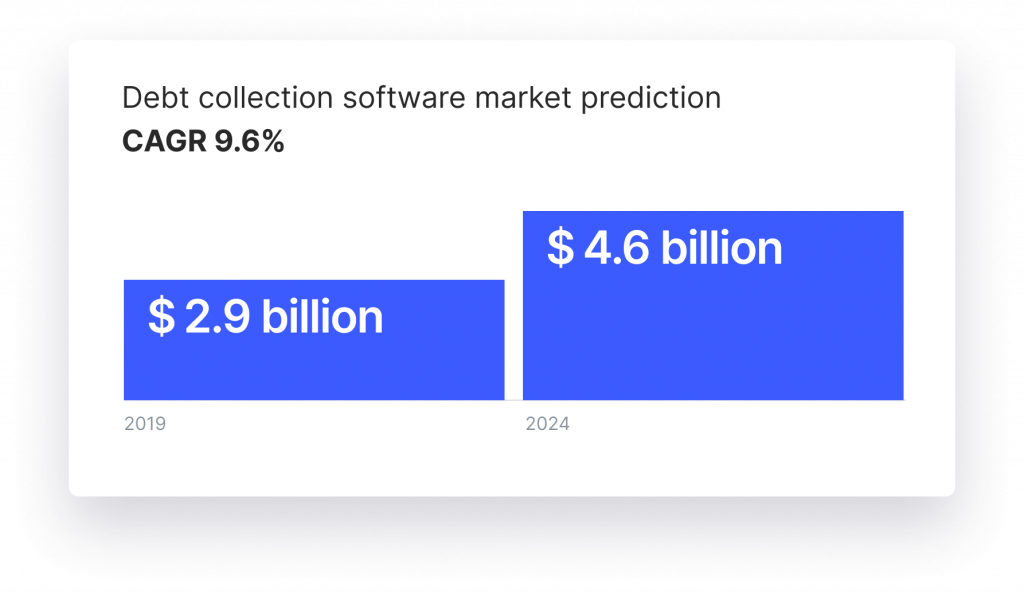
The numbers don’t lie. At the end of 2022, debt in the US hit highs of $16.9 trillion. An increase of $2.75 trillion in just three years. Debt delinquency, otherwise known as non-payment, is also on the rise. Estimated at an approximate sum of 2.5% of all debt, this number amounts to a substantial figure. Considering that out of every $100 debt, only $11.10 is ever recovered, and that’s when companies turn to accounts receivable management (ARM) agencies, debt collection is a priority for lenders.
At the same time, companies are increasingly seeking new technologies that can help them get a better grasp on these numbers and recover higher levels of debt. AI is one such solution with ~75% of lending businesses adopting AI technology and over 81% confident in using their advanced analytics capabilities. But what can AI do for debt collection, and does it really work? Let’s take a look.
What Is an AI Debt Collection Model?
AI debt collection models utilize the latest in AI and machine learning technologies to automate and optimize the debt collection process. By analyzing data, including payment history, outstanding balances, additional debt, etc., such models are able to better predict effective repayment strategies.
At the same time, its uses aren’t limited to calculations, AI debt collection models can be used to generate consistent communication strategies, including email, text, post, to better connect with clients and nudge repayments.
AI debt collection models reduce the need for manual labor in the collection process and allow businesses to improve how debt collection is done, while freeing up staff for more in-depth work.

5 Myths You May Have Heard About AI Debt Collection Scoring
Although it initially appears that these tools could be the future of debt repayment, they are not without their critics. That’s why it’s time to explore the 5-debt collection using AI myths and why they could be blocking you from your business best.
Myth 1: AI Isn’t Accurate
AI is only as good as the data it’s trained on, that’s why inaccurate or incomplete data can give inaccurate results. This is also the case with traditional debt collection. No one can make accurate predictions based on inaccurate or incomplete data.
Truth: AI Needs Good Data to Work Properly
Instead of shying away from technology, lending providers need to lean in and focus on improving their data quality. This means undertaking data completeness checks, regular model updates, model validations and more to ensure that the AI model is working with the best data it can. Unlike manual debt collection, AI is able to process far more data and, as such, can make predictions and generate strategies based on a larger variety of factors.
Myth 2: AI Is Biased
In the past, AI models have been known to show bias. This is because the humans that program them and supply the data sets also have biases, which can leak into AI processes. The same goes for when machine learning is applied, the AI doesn’t always have a choice on which information it is impacted by. However, this isn’t as critical as it sounds. Bias in AI needs to be addressed in the right way to ensure the technology functions as expected.
Truth: AI Bias Can Be Reduced
Just like with humans, AI bias can be prevented to a certain degree with the correct data strategy. First and foremost, having a diverse team allows developers to take in account different perspectives from the get-go. At the same time, developers include a variety of factors that reduce the impact of the bias. For example, adjustable variables (socio-economic status, etc.) could be adjusted to ensure better parity within the results. Additionally, transparent explainable AI tools that allow users to explore how decisions are made could be used to identify and alert potential biases within the system.
Myth 3: AI Invades Privacy
Debt collection often means dealing with tons of data—often extremely sensitive financial data. Concerns regarding the safety and storage of data within AI mean that many lenders remain cautious due to potential privacy breaches, among other factors.
Truth: AI Collection Scoring Uses Identical Data to Traditional Means
Debt collection agencies are often already third-parties, and that’s before other technology providers get involved leading to extra layers of complexity when it comes to protecting data. This means the threshold for protecting information is already high. Modern debt collection systems, by nature, live up to and exceed this expectation by employing safeguards, such as encryption, access controls, and security edits to ensure client data remains secure throughout the process.
Myth 4: AI Isn’t Fair
Artificial intelligence is a relatively new technology, and this often means there is a lot of confusion surrounding it. As such, this sparks claims that it is not transparent or explained, which leads to mistrust. Hence the criticisms that AI isn’t fair.
Truth: AI Can Be Fair and Transparent
Early concerns about technology are to be expected as people get used to innovations and go through the teething problems of adoption. That said, there are also elements of AI that can reduce this impact. For example, explainable AI systems (XAI) deliver explanations for outputs or decisions made on the system. In this way it can allow users to see the decision tree (decision-making logic) that was used to make the decision, making it more transparent than traditional approaches.
Myth 5: AI Isn’t Compliant
Finance and lending are highly regulated industries, so it’s little surprise that this is one of the top concerns of companies when thinking of adopting new solutions. Lenders are often worries that data storage and usage could breach Fair Credit Reporting Act (FCRA) regulations, among others, and this could have serious consequences down the line.
Truth: AI Is Designed to Be Compliant
Although AI technology may appear to be mysterious, such systems are designed with existing laws and regulations built into their logic, meaning this is less of a concern than it may appear to be. However, that said, lenders do need to exercise caution in this area. As technologies emerge, it may take some time to test the models in practice for their compliance. In addition, incompliant datasets used for predictive model building could cause biassed outcomes, which may breech several regulations, making it more important than ever that companies pay close attention to how data is used.
One Reason Why You Need to Consider AI Debt Collection — Today
Debt delinquency is growing, and this trajectory isn’t showing signs of slowing down. However, at the same time, companies are exploring new approaches to dealing with this issue and reducing bad debt.
Although there are no guarantees when it comes to technology, things can go wrong, and that applies to both more traditional software solutions and AI. Adoption of such technology is increasing across a variety of sectors, it becomes a ‘must’ not a ‘want’ to insider adapt AI and machine learning technology. AI delivers the potential to address the growing problem of debt delinquency with smart tools that approach this with a comprehensive strategy.
One such technology is GiniMachine, a tried and tested AI collection tool, that takes care of the entire collection process while reducing the stress and challenges associated with adoption. Get in touch with our team to see how GiniMachine works in action with a free trial.




